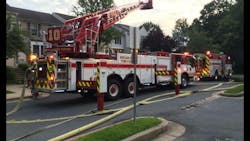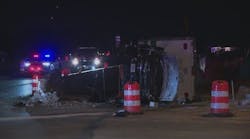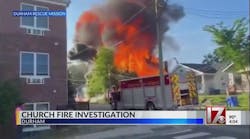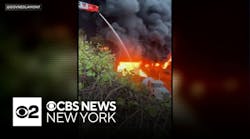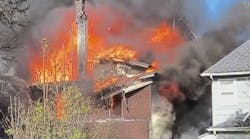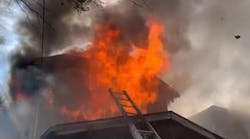One of the most progressive areas in North America is metropolitan Washington D.C./Baltimore, where fire departments have been using automatic mutual-aid “box alarms” for decades.
Prince George’s County is located immediately north, east and south of Washington, D.C. The Prince George’s County Fire/EMS Department (PGFD)’s 44 stations are staffed with 810 career members and approximately 1,500 fit-tested volunteer members, protecting an urban population of nearly one million people.
Howard County is located to the north of Prince George’s and south of Baltimore and is a suburban county. Howard County Fire & Rescue (HCFR) consists of 900 career and volunteer members operating out of 12 stations, protecting a population of just fewer than 300,000.
On July 12, 2015, at 1907 hrs, units from Howard County, Prince George’s County and Anne Arundel County were dispatched to a townhouse fire at 9418 Riverbrink Court, in a subdivision of North Laurel, MD. The fire was ultimately contained to the unit of origin, and structural fire loss was estimated at approximately $230,000.
One fire officer received second-degree burns to his hands during the suppression effort, and after the incident, several concerns were identified about the coordination of efforts among the mutual-aid companies.
Incident summary
The following account is from PGFD Captain Donald Fletcher, who was working his shift as the officer in charge on Paramedic Engine 841:
On Sunday, July 12, 2015, units from Prince George's County Fire/EMS Department were dispatched as part of an automatic mutual-aid assignment to assist nearby Howard County with a reported townhouse on fire. I was working my regularly assigned shift as the officer in charge (captain) on Paramedic Engine 841. While we’re not normally a part of the mutual-aid contingency to Howard County, due to our location, we were clearing a previous call in the area and we were listed as “on the air” in their first due.
Upon receipt of the call for mutual aid, I switched over to Howard County’s “Bravo 1” channel and announced that we were responding with three personnel and asked “what due” we were. Howard County’s communications acknowledged our response and stated that we would be the second-due engine.
Engine 111 and Howard Truck 6 (T6) arrived almost simultaneously. T6 positioned on Side A and reported a two-story, end-of-the-group townhouse with smoke showing from the first and second floors, while E 111 positioned at the end of the adjacent court and reported heavy fire from the basement, first and second floors, as well as the rear deck. T6 repeated conditions in the rear: “I do have three stories from the rear with heavy fire. It’s a walkout basement. We are continuing with exterior operations for now in the fire building.”
Upon arrival, I called out to communications and gave them the address to the hydrant, whose line it was and that I would “have their hydrant.”
During this time, there were several radio transmissions that I wasn’t able to comprehend. I wasn’t able to fully hear what company was the first-due engine, although I thought that I had heard Engine 111 assume the first due. There were also several transmissions from command stating that units were going to be in an “offensive mode”; however, “lines are not to go interior just yet.” I was a little confused and assumed that command had intended companies to be in a defensive mode and planned on transitioning into an interior attack eventually. Command had also stated to “have the second-due engine report to the Bravo 1 exposure” to which I acknowledged, “PE841 copies, Bravo 1.”
Upon arrival, I dismounted the engine and ran toward the fire building to estimate the stretch for my company. With picking up Engine 11’s plug, it left us facing Side D of the fire building and approximately 250 feet to the front door. I came back to the rear step and called for the 400-foot line (400 feet of 1¾ with a automatic fog nozzle.) My driver (Firefighter Scott Radisch) and line man (Firefighter Jamar Blue) stretched the 400 while I went to Side A of the group.
On my trip to Side A, I visualized the first-due company in the rear of the fire unit. The unit had three floors in the rear with a wood deck on division 2 and fire conditions in the basement. The first-due engine was in the rear flowing from the exterior into the basement slider.
I took a peek into the Bravo 1 exposure myself and found clear conditions. I approached the Howard County Battalion Chief (who was in the front yard with a portable radio) and let him know that I was PE841, the Bravo 1 exposure is clear and that we had a line being stretched to Side A. The chief said, “OK” and told me to deploy our line to the front of the fire unit, but to not to go in yet. At this point, we were the only line stretched to Side A.
Once my line man arrived on Side A, I made visual contact with my driver and advised to him to charge the line, to which he acknowledged with a thumbs up. We, along with Truck 810’s crew, began donning our SCBA in the front yard. Once dressed, I told Firefighter Blue that once we got water, we were going to knock down some of the fire from the front door, per the battalion chief.
After what seemed like 2 minutes, our line still was not charged. I ran to Side D to try and make visual with my driver and I found Firefighter K. Hodges (Medic 810) approaching me. Firefighter Hodges stated that Howard Truck 10 re-positioned and accidentally parked on top of our attack line. He then said that they told the driver that he was parked on top of our attack line. I told Firefighter Hodges to do whatever he had to do to get us water, to which he responded, “Radisch is already taking care of it.” About 45 seconds later, a different line was charged and we were finally were able to get water and began flowing through the front door. We flowed water through the front door for 30-45 seconds, at which point C-810 approached me and told me we have the “go ahead” from Command to advance in, and that he would have “Division 1.”
Once inside, we found fire conditions throughout the first floor, with moderate heat and minimal smoke. While knocking down the majority of the fire in the “Charlie” quadrant, I found the basement steps. I took a look down the steps to see the conditions in the floor below us and saw white smoke and steam emitting from the doorway. This led me to believe that crews were in the basement and getting a good knock on the fire downstairs. Throughout our entire time on the first floor, we remained in constant voice and visual contact with the crew from Truck 810.
Once the fire on the first floor was knocked, I met with Chief 810 who advised us to redeploy our line to the second floor. I told Firefighter Blue of our orders and helped him redeploy our line to the base of the steps.
While at the steps, I took a look outside of the front door to see if there were any other companies preparing to come in. The only companies I saw in the front yard were the same battalion chief from Howard County and his aide. Upon looking up the stairwell, I saw fire conditions at the top of the steps.
Chief 810 ascended the stairs first, with Firefighter Blue and myself in tow. After the first few steps, Firefighter Blue was having trouble ascending the steps due to the drywall that had fallen on top of them. I told him to stop and allow me to get ahead of him so that I could clear the steps of the drywall with my hand tool.
As I approached the top step, I suddenly felt the floor drop below me. Reacting on instinct, I stuck my arms out in an attempt to make a “T” and was able to grab a hold of an iron railing on my right-hand side as I fell. I fell a little more than the height of my belly button through the hole before my arms captured. Once my arms captured, I immediately felt an intense amount of heat on both of my hands and began running my LUNAR through my head.
While trying to figure out how to get to my lapel microphone without losing my grip, I shouted out to Chief 810 that I was “through the floor.” I yelled out to him approximately three times before I was able to grab his attention. During this time, I was able to pull myself up to about my thighs and ‘lock out’ (arms retracted/elbows tucked) with my arms, alternating pressure on each hand. Once I had his attention, he came over to me and was able to grab hold of my SCBA straps and assist me the rest of the way out of the hole. My structural gloves seemed to be burned in a closed fist form, so I assumed that I had sustained some significant burns to my hands.
Once out of the hole, I turned around to try and get Firefighter Blue’s attention to see if he was OK. Firefighter Blue had his back turned to me and was attempting to pull more line up the steps. I don’t think he realized that the floor had given way. I was able to grab his attention and told him to pass the line forward and make sure no one else comes up the steps due to the hole. I then called out to command with a message letting him know that there’s been a partial collapse on the stairwell, and requested a ground ladder to the steps to be placed over the hole in the floor. With the help of Chief 10, we extinguished all visible fire on the second floor and hydraulically ventilated out of the Side A window.
Once all the smoke was clear, Firefighter Blue was able to make his way around the hole and met up with me. Firefighter Blue stated that his vibra-alert had just started to go off and that he was in his last quarter of air. I made a transmission to command that all fire was knocked, that I had a member in his last quarter of air, and requested a relief company.
Once the relief company arrived, I gave a brief report and exited the building on Side A and began undressing out of my gear. As I undressed, I immediately noticed blisters to my palms and fingers.
I approached the Howard County battalion chief, who was still on Side A, and told him of the conditions that we found inside. I also told him that I had fallen and grabbed onto a super-heated railing that had burned my hands. He let me know that he would contact the safety officer and make him aware.
I made my way back to PE 841 to let my crew know that I needed to go to the hospital and also check on how they were doing. I asked Firefighter Radisch how things went, and he reported that there were several issues but he was able to overcome all of them. I looked around and noticed that Howard Tower 10 (TWR 10) was parked on top of a broken section of our attack line. I asked the driver from TWR 10 how our line ended up under their duals if they arrived ahead of us. The driver explained that he repositioned after their arrival. I asked him as to why he didn’t move again after being made aware that he was positioned on an attack line or at least raise the already deployed outriggers high enough to free the attack line. He simply said, “I had to get my aerial up.”
Discussion points
Some areas of the country have only recently discovered the value of automatic mutual aid. Sadly, some fear that another department or company “getting to the fire first” damages their sense of pride—a purely stupid assumption. Automatic mutual aid ensures that the closest, most appropriate help gets to the fire as soon as possible.
As noted, the departments involved in this Close Call have been using automatic mutual aid for decades, and it works seamlessly in nearly all cases. Specifically, PGFD and HCFR operate together daily and enjoy a long history of good working relations. Like anything though, on occasion, the system doesn’t “sync” as well as hoped, resulting in lessons learned, opportunities to improve and a chance for us all to learn.
With that in mind, the following points were discussed among myself, Captain Fletcher, PGFD Fire Chief Marc Bashoor, Howard County Fire Chief John Butler and Deputy Chief John Jerome.
#1: Familiarity with local policies
The crew from 841 was unfamiliar with Howard County’s fireground orders, including arrival order of fire apparatus and their operational tasks. There were radio terms that were unclear during the initial stages of the operation, creating a bit of confusion.
Action taken: A copy of HCFR’s fireground, communications and ICS policies were requested and provided to all PGFD personnel, who will also receive training on HCFR procedures.
Suggestion: Multi-jurisdictional drills should be held at least quarterly to identify gaps in radio terminology, policy and procedures, and familiarity with personnel.
Readers: How familiar are you with your mutual-aid department procedures? Do you use standardized terminology?
#2: Apparatus and equipment familiarity by communications personnel
HCFR acknowledged PE 841 as PE 849 while en route.
Suggestion: Follow-up is required between HCFR’s dispatch center and PGFD Communications to ensure proper radio identifications of mutual-aid companies. It would also be beneficial for this review to occur with all mutual-aid jurisdictions. Finally, improved coordination of what mutual-aid unit is actually responding, as opposed to what was requested, is needed.
Readers: The role of dispatchers and communications is especially critical during incidents involving mutual aid. What systems does your dispatch center have in place related to mutual-aid operations?
#3: Apparatus placement awareness
Upon PE 841’s arrival, they deployed a 400-foot pre-connected attack line from their own piece, and then TWR 10 parked on top of it during final positioning. This caused a significant delay in companies having a charged attack line on Side A of the fire unit. The apparatus was more than 200 feet away from the main fire building.
Action taken: This was addressed in a meeting with the on-duty HCFR battalion chief, their assistant fire chief (bureau chief of emergency services) and Battalion Chief 886. Additional follow-up/investigation is being handled by HCFR.
Suggestion: Crews shall discuss the urgency of a request such as this. When positioning apparatus, it is paramount for drivers/operators to remain cognizant of obstacles, including hoselines. When it is brought to the attention of a driver/operator that they have parked on a hoseline, they should take immediate steps to remedy the situation.
#4: Flow paths, venting and coordination with engine companies
Truck 810 arrived as the fourth-due truck and reported to the A side of the fire unit. Crews started ventilating and forcing entry on the A side prior to a hoseline being charged and in place. Crews were warned by BC1 to wait until a hoseline was in place. In an interview with Truck 810’s unit officer, he stated that the window was already partially ventilated prior to their arrival, and that they were just clearing the remaining glass and frame. It’s important for fire officers and firefighters to understand that the transitional attack is a tactic, not an overall incident strategy.
Suggestion: Departments must do a better job teaching companies about proper ventilation techniques, especially as recent studies have provided important data on this critical subject. Fires should be kept ventilation-limited until effective fire attack can be made. All ventilation actions should be coordinated by Command. Some ventilation actions taken by units on this incident were done without coordination from Command and before an effective fire attack could be made. This likely contributed to increased fire spread and greater risk to interior fire attack operations.
Readers: What’s burning in today’s buildings is nastier than ever. Read, study, understand and drill on flow paths. Well-managed flow paths result in lives being saved and fires getting knocked down faster. Understand that it’s 2015, and we have more than enough proof that uncoordinated ventilation must be a behavior of the past.
#5: Collapse
The captain from PE 841 fell through a section of stairs while extinguishing the fire, requiring him to be rescued by C 810. He was unable to call a mayday because of the injury to his hands.
Action taken: Crews were reminded about continuously monitoring the structural stability of various occupancies during fire operations, to include the building itself, floor, roof and stairways.
Suggestion: Sounding floors, roofs and stairs during operations should be continuous, especially when fire conditions are present. Crews operating in an IDLH atmosphere should remain within sight or, at the very minimum, within voice contact of their partners.
Readers: How often do you and your members take time to truly understand and study building construction? Do you understand that in so many cases, the “structures” you are entering are held together by glue and shreds of wood? Is that a brick house or a frame house with a brick façade? Take the time to study the building construction in your area and learn the hazards that each construction feature may present.
#6: Command, control and following the assignment
Command assignments and roles must be clearly stated from the start. Command must make all assignments clear over the radio, keeping in mind that command may very well be the first-arriving company officer. On this incident, several units were assigned “to assist” other units, rather than to work for an established ICS supervisor.
The initial IC, twice on the radio, declared the overall incident strategy as “Offensive now from the exterior only.” There are two choices for overall incident strategies, offensive and defensive. Command anticipated making an interior attack, and set the strategy to offensive, and set the initial tactic to exterior attack.
Command officers who respond or self-dispatch to incidents should be sure to integrate into the command structure for the incident. Several chief officers on this incident did not integrate into Command assigned roles, but rather operated as “independent” officers on the scene.
Action taken: Officers were reminded about the critical importance of having true command, control and accountability—with clear communication so that every company and officer understands what they are expected to do. Once command is established (pass from the first-arriving company officer) the IC must use a tactical worksheet as a part of knowing, understanding and documenting who is doing what.
Readers: Simple questions: Do your companies, by policy and action, routinely understand their assignments as communicated by command? Do officers arrive on scene and report to command for an assignment, or do they show up and operate on their own? Does your department and mutual-aid partners use the same tactical worksheet?
#7: Terminology standardization
Command asked that the second-due engine (PE 841) take a position on Side A on Riverbrink Court as opposed to “picking up” E 111’s line on Harvest Way. PE 841’s OIC marked on the scene stating, “Paramedic Engine 841 has 11’s line.”
Action taken: All PGFD crews were reminded to ensure that they understand the orders given by the IC.
Readers: Determine what means what in your area versus what someone likes to say on the radio. Policy and training must determine terminology so that we understand each other during the most stressful of times.
#8: Common hose threads and adapters
There were no appliances on PE 841 that were compatible with Howard County fire hydrants. Howard County has 5.437-inch steamer threads. This caused a delay in PE 841’s driver connecting to the hydrant on Harvest Way. When he approached the driver of E 111, the driver told him he’d help after he got some spare SCBA cylinders ready for his crew. The driver from PE 841 found the appropriate appliance on his own after searching through the compartments of E 111.
Action taken: Orders have been submitted to a vendor for the appropriate devices for future occurrences for Co. 831/831, as well as for border companies of Washington, D.C.
Suggestion: Stations that could potentially respond out of county should have the appropriate adapters and appliances during mutual-aid events. PGFD should consider these various appliances as being part of the county spec for fire apparatus. This would greatly benefit the PGFD (and those they are assisting) during large-scale events in the future.
Readers: While your "border" companies may have adapters, there are times where companies are out of position but due on a fire. Now would be a good time for you and your leadership to determine if there is ANY possibility that your apparatus may not be able to connect.
Note: Did you know that in 1873, the International Association of Fire Chiefs (Fire Engineers back then) proposed the first national standard to ensure that hoses from one jurisdiction fit others? We are still working on that.
Concluding thoughts
The companies that operated on this fire did a good job confining the fire to the unit of origin, but some significant operational issues were identified. Most of the operational deficiencies have been identified and addressed accordingly.
This event has allowed the command staffs of both PGFD and HCFR to positively reach out and discuss previous operational concerns, the issues identified within this report, as well as future plans to meet quarterly to discuss upcoming policy changes, staffing complements and operational issues.
In the grand scheme of things, the injuries sustained to Captain Fletcher were minor, but they had the potential to be catastrophic. Fortunately, we can use his story as an opportunity to learn.
My sincere thanks to Captain Fletcher and all those operating at the scene that day. Additional thanks to HCFR Fire Chief Butler, Deputy Chief Jerome, Assistant Chief Wallace and Battalion Chief Bean; PGFD Chief Bashoor, Assistant Chief Cardello and Acting Battalion Chief Bird; and Laurel Volunteer Fire Department Company 10, Chief Hull and Deputy Chief Grant for their assistance with this report.
Further, this month’s column is dedicated to the memory of Prince George’s County Deputy Fire Chief Carla Blue (ret.), mother of Firefighter Jamar Blue. Chief Blue was tragically killed in a car crash as we were working on the piece. RIP.
